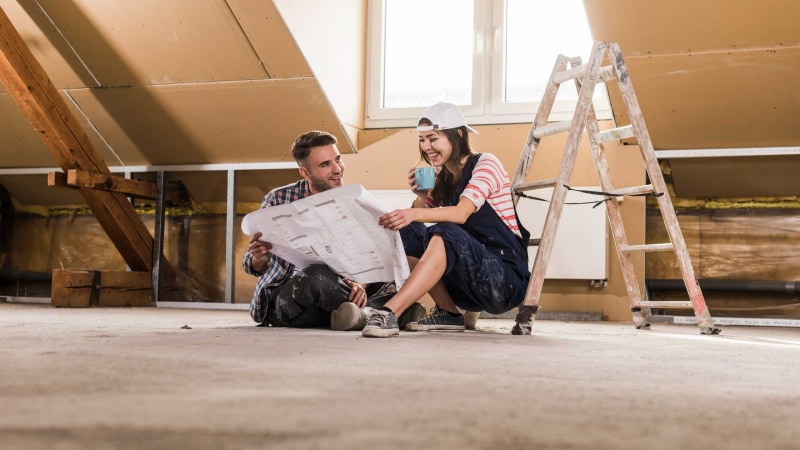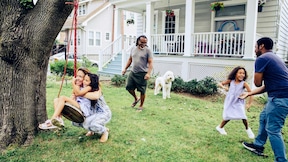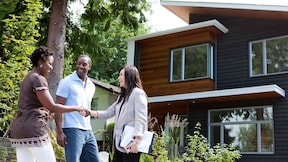Kit homes explained

“This article is for educational purposes only. JPMorgan Chase Bank N.A. does not offer kit home loans at this time. Any information described in this article may vary by lender."
Kit homes are a type of prefabricated home. Also known as “prefab” homes, these home structures are built off-site at a manufacturing facility and brought to your property site for assembly. There are a few different types of prefabricated homes, each with its own little twist on how it’s manufactured, how it arrives and ultimately, how it’s assembled. Let’s take a deeper look at the kit homes and how they fit within the prefabricated family.
What is a kit home?
Kit homes may not be what you’d traditionally think of when buying or building a house. If you’re buying a house, you might work with a real estate agent, visit a few options and eventually choose the right home for you. With kit homes, it’s more akin to perusing a catalog. When you find the one you like, you’ll purchase it from a manufacturer, have it delivered and put your new home together.
Kit homes are different than traditional homes in their construction process too. Kit homes are known to be the most do-it-yourself-friendly style of prefab homes. The home comes in pieces with directions on how to put it together.
While you do choose the kit home you like, you aren’t designing it from scratch like you would with a traditional on-site or “stick-built” home. With a traditional build, a contractor would bring in the raw materials and do everything — from cutting and sanding, to building and painting — onsite. With a kit home, the pieces are sourced, built and finished at the manufacturer facility. When they arrive onsite, you (or a contractor) are simply putting the finished building blocks together.
Building a house from a kit
Depending on your skillset, you might build your own kit home or hire a contractor to do it for you. When it comes to details beyond the main structure of your kit home, like bathrooms and plumbing, these will typically need to be handled separately as many kits are unlikely to arrive with a toilet stuck to the floor — convenient as it sounds, it’d be a lot harder to ship intactly.
Another notable feature of kit homes is the different home styles you can choose from. While some types of prefabricated homes may be limited in design, kit homes typically have a repertoire of styles to choose from.
Whether you opt to build your kit home yourself or decide to hire a professional, here are some styles you might come across:
- Bungalows: Bungalow kit homes may be great for a vacation home or a cute little place right on a lake. You may be able to customize the floor plan in some cases, and it’s estimated to take about one to two weeks for experienced builders to assemble.
- Cabins: Interested in cozying up in a cabin style kit home? This style may take only four days for experienced builders to complete.
- Ranch-style: Ranch-style homes are horizontally built structures that contain everything on the same floor. Ranch-style kit homes may be a more approachable option if you’re building a kit home for the first time due to their leveled nature.
- Tiny home: If you’re looking to put your house on wheels, you might want to consider a tiny kit home. Depending on the company, tiny kit homes may be structured intentionally for mobile life, with areas for attaching wheels on the bottom of the structure.
Kit home prices
Although kit homes are typically less expensive than buying or building a traditional home, the overall cost will depend on factors like your location, layout and the size of the home you want. It will likely depend on the company you buy from and the quality of the materials. By researching various manufactures online, you may gather a baseline understanding of the cost.
Pros and cons of kit houses
Like any home purchase, there are pros and cons that come with buying a kit home. For example:
Pros
- Cost: As mentioned, the cost of a kit home is typically lower than the cost of building (or buying) a traditional stick-built home depending on the size, location and materials.
- Getting to build a new home: The exciting thing about a kit home is you’re getting to build a new home from scratch. You get to pick the model you want, put it together and ultimately design the rest of the home as you see fit.
- Less waste: Kit homes are considered an eco-friendly approach to home building because they are produced with exactly what they need and arrive without excess materials or waste.
- Quick assembly: Compared to other modes of construction, kit homes are assembled relatively quickly. Some might take only a matter of days, compared to the potential weeks or months it typically takes to build a traditional home model.
Cons
- Zoning regulations: Zoning regulations must be kept in mind when building a kit home. Zoning regulations may impact where you want to build, and ultimately live, in your kit home.
- May be difficult to build alone: While kit homes are marketed as “easier” to build, it doesn’t always guarantee that they are. Just like any DIY adventure, you may find yourself needing to call in for professional help.
- New building concept: Kit homes are a relatively new building concept. If you’re worried about the quality and safety of your build compared to traditional homes, this may be something to think more about.
- May still be expensive: While kit homes are meant to be less costly than traditional models, depending on the style and company you purchase the kit from, it can still be costly. At the end of the day, you’re still building a somewhat sizeable dwelling unit.
Financing a kit home
You may be wondering if you can finance a kit home. A kit home is considered factory-built housing, which must assume the characteristics of site-built housing and meet local building codes to be considered. Depending on the kit home, the type of loan you’re looking for, your personal qualifications and the lender, you may be able to find a home loan that works for you.
In summary
Kit homes are prefabricated homes that come with ready-to-build instructions. Depending on the style of kit home you choose, you may be able to build the home yourself or hire a contractor to help. Kit homes have a relatively quick assembly time, produce less waste due to the production style and are likely less costly than your traditional stick-built model. While it’s possible to finance a kit home, it may be more complicated than applying for a traditional mortgage.



